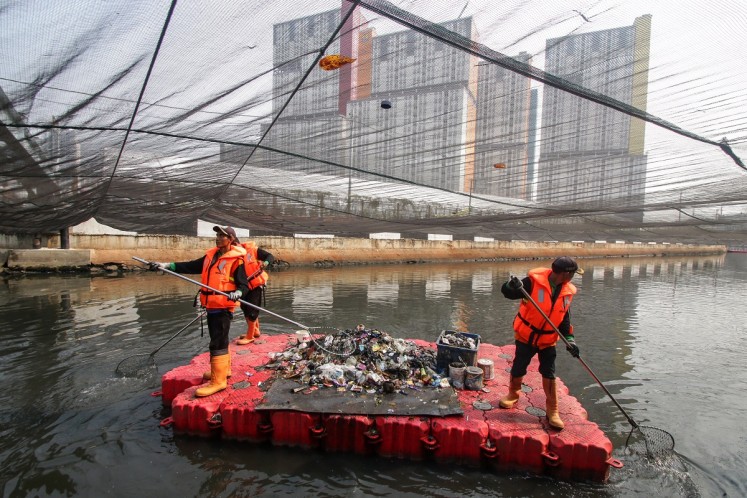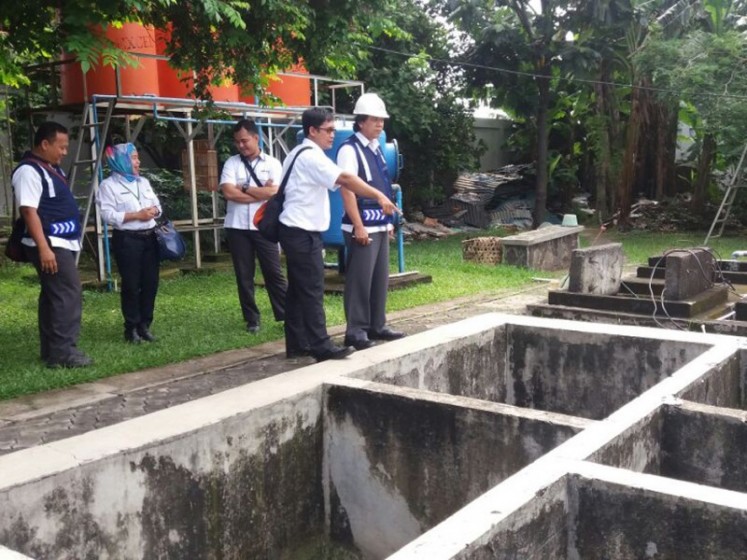Popular Reads
Top Results
Can't find what you're looking for?
View all search resultsPopular Reads
Top Results
Can't find what you're looking for?
View all search resultsWhat makes Jakarta’s rivers ugly and smelly?
Jakarta's rivers are dirtier than the Citarum River, which is often referred to as "the world's most polluted river".
Change text size
Gift Premium Articles
to Anyone
This month, the Jakarta administration covered an eyesore of a river with a giant nylon net ahead of the 18th Asian Games in August.
The Sentiong River, nicknamed the black river by locals, is murky and smelly because, according to a city official, wastewater from houses and a tofu factory is dumped untreated there. The Sentiong River is not the only heavily polluted river in Jakarta. In fact, all 13 rivers in Jakarta and their dozens of tributaries are highly polluted.
How polluted?
The Jakarta Water Resources Council stated that the rivers in Jakarta could only supply 2.2 percent of the total demand for clean water, all of which came from the Krukut River, as the other rivers were too dirty to process.
City workers clean the Sentiong River under a giant nylon net in Central Jakarta on July 21. The city administration covered the river in an attempt to ward off the smell ahead of the 18th Asian Games in August. (Antara/Rivan Awal Lingga)In addition to the more visible solid trash that is picked up by the “orange troops” – sanitation workers that were first deployed under the leadership of former governor Basuki “Ahok” Tjahaja Purnama – Jakarta’s rivers contain highly toxic wastewater.
The National Development Planning Board (Bappenas) reported in February that 96 percent of river water in the city is severely polluted. The rivers are contaminated with high levels of biochemical oxygen demand, phosphor and nitrogen.
Some 20 percent of the raw water supply for Jakarta comes from the Cisadane River in Tangerang, Banten, and the remaining comes from the Jatiluhur Reservoir in West Java, which receives water from the Citarum River, dubbed “the world’s most polluted river” by international media.
Why and how?
Jakarta rivers receive an estimated 2.5 million cubic meters of wastewater per day. More than 70 percent of the wastewater comes from millions of households and the remaining comes from commercial buildings and industrial activities.
Household wastewater is sourced from the population’s “gray water” or detergent water, other kinds of household wastewater and “black water”, which is wastewater from feces.
The 2009 law on the environment prohibits companies from dumping wastewater into rivers; however, poor supervision and law enforcement have resulted in companies polluting rivers without consequence.
In March, water in the East Flood Canal in Marunda, North Jakarta, was covered with white foam that had a pungent smell.
Wahyu Perdana, the campaign manager for food, water and essential ecosystems at the Indonesian Forum for the Environment (Walhi), said that, based on monitoring conducted by the organization a few years ago, the water in the canal had a sulfur smell. “Judging by the characteristics of the smell, we suspect that the pollution came from textile factories. The factories wash the clothes with detergent,” Wahyu said.
The city administration said the suffocating smell emanating from the black river was also partly due to a nearby tofu factory that dumped untreated wastewater into it.
Jakarta’s sole wastewater treatment plant (IPAL) is located in the Setiabudi Reservoir in Central Jakarta. It can only treat about 2 percent of wastewater, which comes not only from households in Jakarta but also from millions of houses, factories, commercial buildings and agricultural fields in upstream areas.
Excavators dredge the West Setiabudi Reservoir in South Jakarta on Monday. Setiabudi only treats about 2 percent of waste water, which comes not only from households in Jakarta, but also from millions of houses, factories, commercial buildings and agricultural fields in upstream areas. (JP/Berto R. Wedhatama)How do we clean the rivers?
The government has long planned to develop the Jakarta Sewerage System (JSS) to process household waste at the Jakarta IPAL before the water is pumped into rivers.
The system is expected to reduce pollution in Jakarta’s 13 rivers, provide clean water and stop residents from pumping groundwater, an activity that has resulted in land subsidence.
However, development of the JSS, which was scheduled to kick off last year, has been postponed to 2019 for various reasons.
The JSS is set to manage waste treatment in 15 zones, including Zone 0 at the Setiabudi Reservoir, with an initial focus on zones 1 and 6.
Zone 1 will be situated on a 4.9-hectare plot of land in Pluit, North Jakarta, while Zone 6 will be situated on a 5.8-hectare plot of land in Duri Kosambi, West Jakarta. Zone 1 and 6 will be able to process 198,000 and 282,000 cubic meters of wastewater per day respectively.
The cost of the Zone 1 project is around Rp 8.1 trillion (US$ 614 million) while the Zone 6 project is around Rp 8.7 trillion. The Japan International Cooperation Agency will bear about 55 percent of the total cost through a loan scheme.
The president director of city-owned wastewater treatment firm PD PAL Jaya, Subekti, said the company was conducting detailed engineering for the development of the system in Zone 1.
“We hope that the detail engineering can finish in mid-2019 and the construction can begin in 2020. The project is set to finish in 2026,” Subekti said recently.
After finishing both zones, the project will continue in 12 other zones across the city.
Subekti said the project would be time-consuming and cost a lot of money as the pipes for the system would be placed 20 to 30 meters underground. Furthermore, with building foundations already occupying space underground, installing the pipes would be difficult.
“To find investors interested in the project might also be challenging, as the project might not bring much of a profit,” he said.
Are there alternatives to the large-scale JSS?
PAL Jaya has planned to take another approach – the subzone approach – to treat wastewater, and it is all about starting small.
To treat wastewater at Ancol Dreamland in North Jakarta, for example, it would start by installing a pipe that would treat wastewater. “We have also conducted a study to treat water in industrial areas and several office buildings in Jakarta,” he said.
The city administration has urged the management of high-rise buildings to operate their own IPALs.
In March, Jakarta Governor Anies Baswedan raided buildings along Jl. Sudirman and Jl. MH Thamrin and asked management teams to install infiltration wells, preserve groundwater and treat wastewater.
In addition to the two thoroughfares, the city administration has also inspected buildings in industrial areas in East Jakarta and West Jakarta.
What about informal settlements?
An informal settlement in Malakasari in Duren Sawit, East Jakarta, has had its own communal wastewater treatment system since 1998, using both aerobic and anaerobic processes. The wastewater treatment plant was built by the city administration and managed by the community and PAL Jaya.
Officials from the city administration and city-owned wastewater management firm PD PAL Jaya inspect a communal wastewater treatment site in Malakasari, East Jakarta, in 2017. (Courtesy of Water Management Agency/-)Urban-water spatial planner Prathiwi Widyatmi Putri said it would be difficult for the city administration to realize the idea of developing a centralized sewerage system. Apart from the high cost of installing big pipes, many problems could arise during the process.
She suggested that the administration install sewerage systems in smaller areas, including informal settlements, such as subdistricts or neighborhoods like Malakasari, as it would cost less and pose fewer risks to other utility systems.
She emphasized that communal sewerage systems would also reduce the time it takes for water to be processed and distributed as clean water.
Why should we take on the difficult task of cleaning the rivers?
Cleaner rivers in Jakarta more than just make them visually and olfactorily acceptable to residents. It also means Jakarta tap water operators would have a greater raw water supply, which would allow them to expand their tap water coverage in the city. The operators have long complained about a lack of raw water supply to improve their tap water coverage, which stands at about 60 percent.
The polluted rivers have also degraded the quality of the Jakarta Bay ecosystem. Fisherfolk in Muara Angke, North Jakarta, often complain about catch declines, allegedly because of pollution from the rivers.
Bogor Agriculture Institute scholar Alan F. Koropitan studied the Jakarta Bay and found that the water had “become a wastewater disposal site for Jakarta, and domestic sewage, and industrial and agricultural waste, are deposited in it”.
"It will be a difficult task, but when it is accomplished it will be a source of national pride," said Alan. (evi)













